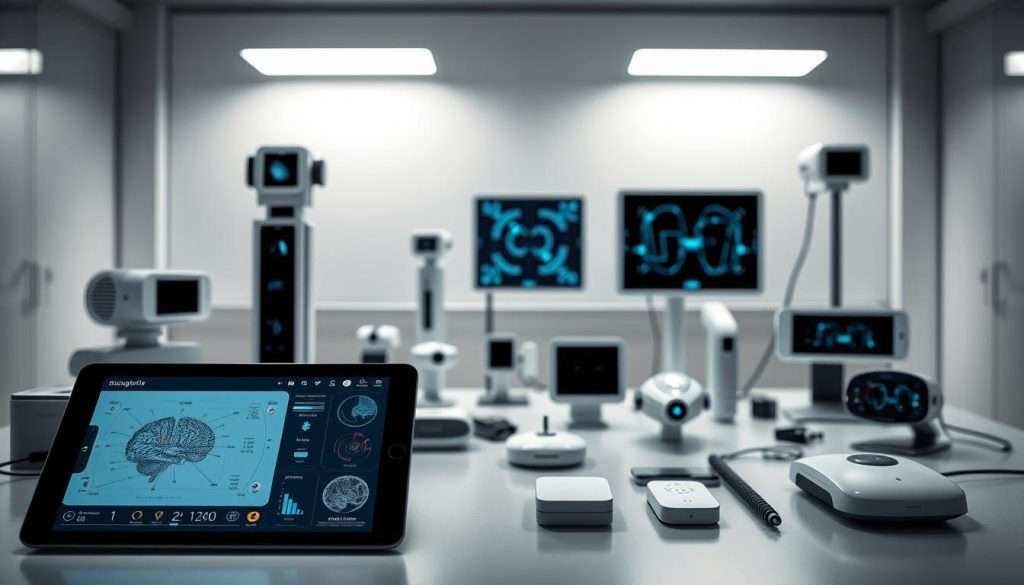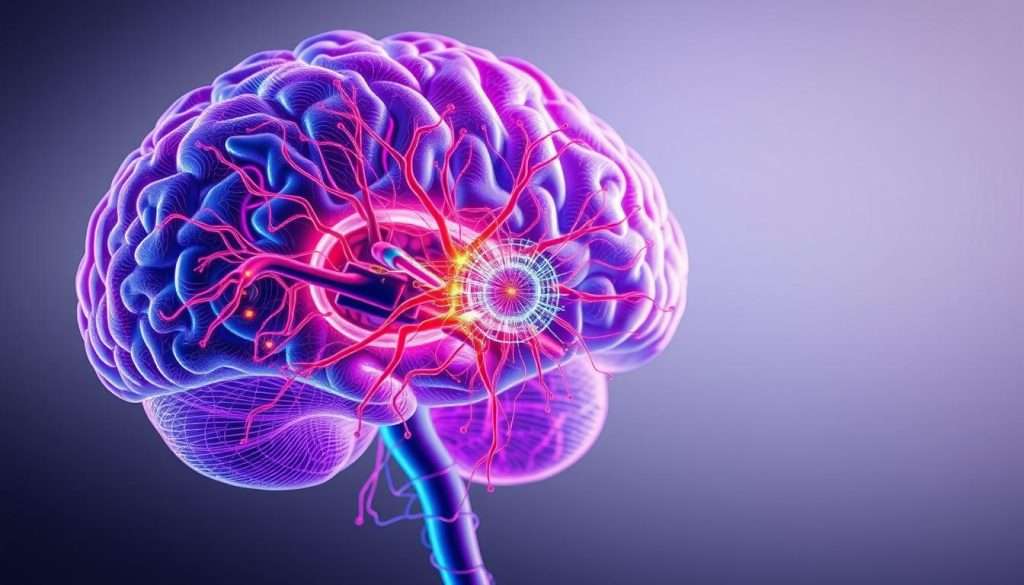Welcome to our journey into neuroplasticity! We’re thrilled to show you how your brain can change and grow. Your brain isn’t set in stone; it’s a dynamic place that changes with your experiences.
In the world of brain plasticity, you’ll learn how to use your brain’s power. You’ll see how to boost your thinking skills and feel better overall. Neuroplasticity shows us that our brains can change and adapt at any age. This lets us learn, grow, and heal from injuries.
Key Takeaways
- Neuroplasticity allows your brain to change and adapt throughout your life.
- You can improve your cognitive abilities through practices that promote brain plasticity.
- Embracing neuroplasticity can lead to better overall well-being.
- Your brain’s ability to adapt is key to learning and recovery.
- Harnessing the power of neuroplasticity can transform your life.
The Science Behind Neuroplasticity
Think of your brain as a dynamic, ever-changing landscape. Neural pathways are constantly being reshaped. This concept, known as neuroplasticity, shows the brain’s ability to adapt and change throughout life.
What Is Neuroplasticity?
Neuroplasticity is the brain’s ability to form new neural connections. This allows for learning and recovery from injuries. It’s like building new roads in a city to improve traffic flow or detour around congested areas.
How Neural Connections Form and Change
Neural connections are formed and modified based on your experiences. The more you practice a skill or recall a memory, the stronger the associated neural pathways become. On the other hand, pathways that are not used can weaken over time.
The Brain’s Remarkable Ability to Reorganize
The brain can reorganize itself in response to injury or new learning experiences. For instance, if one area of the brain is damaged, other areas can compensate by taking over the lost functions. It’s like a network rerouting traffic during road closures.
| Aspect of Neuroplasticity | Description | Example |
|---|---|---|
| Synaptic Plasticity | The strengthening or weakening of connections between neurons. | Learning a new language strengthens the connections between neurons involved in language processing. |
| Neurogenesis | The growth of new neurons in certain parts of the brain. | Exercise can promote neurogenesis, potentially improving cognitive function. |
| Functional Reorganization | The brain’s ability to reassign functions to different areas. | After a stroke, other areas of the brain may take over functions lost due to brain damage. |
Understanding Brain Plasticity Throughout Life
Your brain is more adaptable than you think, thanks to neuroplasticity! It changes and adapts throughout our lives, not just in childhood. Let’s look at how brain plasticity changes at different life stages.
Childhood Brain Development
In childhood, the brain grows fast, making new connections quickly. This is key for building future thinking skills. Neuroplasticity helps kids’ brains heal and adjust to new places.
Adult Neuroplasticity Potential
As adults, our brains can still change. By trying new things and learning new skills, we can grow new brain cells. This boosts our thinking skills and keeps our brain healthy.
| Age Group | Brain Plasticity Mechanisms | Cognitive Benefits |
|---|---|---|
| Childhood | Rapid neural connection formation | Foundation for future cognitive abilities |
| Adulthood | Neurogenesis, synaptic plasticity | Enhanced cognitive flexibility, brain health |
| Older Age | Compensatory mechanisms, neural adaptation | Maintained cognitive function, reduced decline |
Maintaining Cognitive Flexibility as You Age
Even as we get older, our brains can still adapt. Doing mentally challenging activities, exercising, and staying social helps keep our brains sharp.
By understanding and using brain plasticity, we can help our brain health at any age.
The Biological Mechanisms of Brain Rewiring
Your brain is always changing. But how does it do that? It’s through complex processes that let your brain adapt and evolve over time. Let’s dive into the world of brain plasticity and see what science says about it.
Synaptic Plasticity Explained
Synaptic plasticity is key to brain rewiring. It’s how connections between neurons change with activity. When you learn something new, these connections get stronger. This is crucial for learning and remembering things.
But how does it happen? Simply put, synaptic plasticity lets your brain adjust and improve its connections based on new experiences.
Neurogenesis: Growing New Brain Cells
Neurogenesis is another important part of brain plasticity. It’s the growth of new brain cells, even as an adult. This shows that we’re not stuck with the same number of neurons forever.
Things like exercise, diet, and mental challenges can boost neurogenesis. This means you can improve your brain health.
Pruning: How Your Brain Optimizes Neural Pathways
Pruning is how your brain makes its connections better. It gets rid of connections that aren’t needed. This makes your brain work more efficiently.
Pruning is vital for making your brain’s circuits sharper and improving how well you think.
Knowing about these processes can help you take care of your brain. By using synaptic plasticity, neurogenesis, and pruning, you can make your brain more flexible and strong. So, what will you do to use brain rewiring to your advantage?
Assessing Your Current Neural Patterns
Looking at your neural patterns can show where you can get better at thinking. It’s key to know how your brain connects to make changes. Start by thinking about your thoughts and what you’re good at.
Identifying Limiting Thought Patterns
Thought patterns that hold you back can limit your thinking. To spot them, think about your daily thoughts and actions. Ask yourself:
- Are there recurring negative thoughts?
- Do you often find yourself stuck in a particular mindset?
Spotting these patterns is the first step to changing them.
Recognizing Cognitive Strengths and Weaknesses
Knowing your strong and weak points in thinking helps you improve. Think about these:
| Cognitive Area | Strengths | Weaknesses |
|---|---|---|
| Memory | Good recall of past events | Struggling to remember recent details |
| Problem-Solving | Effective in logical reasoning | Difficulty in creative problem-solving |
Self-Assessment Tools for Neural Flexibility
There are many tools to check how flexible your brain is. You can find cognitive tests and quizzes online or on apps. 
These tools help you see how you’re doing and where you need to get better.
By understanding and checking your neural patterns, you start improving your neuroplasticity and brain health.
7 Practical Techniques to Enhance Neuroplasticity
Unlock your brain’s potential with these 7 practical techniques. They boost neuroplasticity and enhance cognitive flexibility. By adding these methods to your daily routine, you can improve your brain’s adaptability.
Daily Mental Exercises for Cognitive Stimulation
Engaging in mentally stimulating activities is key for cognitive function. Try these daily mental exercises to keep your brain sharp:
- Solve puzzles or play brain games like Sudoku or crosswords.
- Learn a new language or skill through online courses or apps.
- Practice memory exercises, such as memorizing lists or sequences.
Physical Activities That Boost Brain Plasticity
Physical exercise is good for your body and brain. Regular physical activity enhances brain plasticity and improves cognitive function. Consider these exercises:
- Aerobic exercises like running, cycling, or swimming.
- Resistance training to build strength and boost brain health.
- Yoga or tai chi for flexibility and stress reduction.
Nutrition for Optimal Neural Function
A balanced diet rich in essential nutrients supports neural health and promotes brain plasticity. Focus on consuming:
Key Nutrients for Brain Health
- Omega-3 fatty acids found in fish and nuts.
- Antioxidants in berries and leafy greens.
- Vitamin D from sunlight, supplements, or fortified foods.
Dietary Patterns That Support Neural Growth
Incorporate these dietary patterns to support neural growth and overall brain health:
- The Mediterranean diet, rich in fruits, vegetables, and healthy fats.
- A diet high in fiber to support gut health, linked to brain health.
- Adequate hydration by drinking plenty of water throughout the day.
By combining mental exercises, physical activity, and a balanced diet, you can enhance your brain’s neuroplasticity and cognitive function.
Harnessing Mindfulness for Neural Restructuring
Mindfulness is a powerful tool for changing your brain. It helps you rewire and strengthen your neural connections. By adding mindfulness to your daily life, you can boost neurogenesis and synaptic plasticity. This leads to better thinking and a stronger brain.

How Meditation Physically Changes Your Brain
Meditation changes your brain’s structure. It improves areas for attention, emotions, and memory. Regular practice can grow gray matter in the hippocampus, key for learning and memory.
A study showed that mindfulness meditation for eight weeks changes the brain. It increases density in memory, learning, and emotional areas.
5-Minute Mindfulness Practices for Beginners
Starting mindfulness is easy. Just spend a few minutes each day on focused breathing or body scans. Here are simple practices to begin:
- Focus on your breath for five minutes, feeling the air in and out of your nostrils.
- Do a body scan, lying or sitting, focusing on each body part, letting go of tension.
- Use a guided meditation app or video for a mindfulness exercise.
Progressive Meditation Techniques for Deep Neural Change
As you get better at mindfulness, try more advanced techniques. These can deepen your brain changes. Some include:
| Meditation Technique | Benefits | Tips for Practice |
|---|---|---|
| Loving-kindness meditation | Increases compassion and empathy | Start with yourself, then extend kindness to others |
| Focused attention meditation | Improves concentration and attention | Use a physical object, like a candle flame, to focus on |
| Open monitoring meditation | Enhances awareness of thoughts and emotions | Observe your experiences without judgment or attachment |
Adding these techniques to your mindfulness routine can keep challenging and changing your brain. This promotes deeper neural restructuring and cognitive growth.
Learning New Skills to Build Stronger Neural Pathways
Learning new skills can change how our brain works. It helps us make new connections that boost our thinking skills.
Why Novel Experiences Transform Your Brain
New activities change our brain a lot. This is called neuroplasticity. It lets our brain adjust to new things.
Key changes include:
- Increased gray matter in areas related to the new skill
- Enhanced connectivity between different brain regions
- Improved cognitive flexibility
Neuroscience-Based Learning Strategies
To get the most from learning, use science-backed methods. These include:
- Spaced repetition to reinforce new neural connections
- Interleaving different skills or subjects to enhance cognitive flexibility
- Active recall to strengthen memory and retention
Top Skills That Maximize Cognitive Flexibility
Some skills are better than others for improving thinking. These include:
- Learning a new language
- Playing a musical instrument
- Engaging in complex physical activities
Adding these skills to our lives boosts our brain’s adaptability.
Breaking Negative Thought Patterns Through Neuroplasticity
Neuroplasticity is a powerful tool for overcoming negative thoughts. It shows us how our brains can change and adapt. This knowledge is the first step towards a more positive outlook.
Identifying and Disrupting Harmful Neural Loops
Negative thoughts can become stuck in our brains, forming hard-to-break neural loops. But, by noticing these patterns, we can start to change them. We can learn to recognize what triggers these thoughts and find ways to see them in a better light.
- Pay attention to your thoughts and identify patterns that are holding you back.
- Challenge negative thoughts by asking yourself if they are based on facts or assumptions.
- Practice mindfulness to become more aware of your thoughts and feelings.
Step-by-Step Cognitive Restructuring Techniques
Cognitive restructuring is a strong method for changing negative thoughts. It involves a step-by-step process to replace negative thoughts with positive ones.
- Identify the negative thought you want to change.
- Assess the evidence for and against this thought.
- Replace the negative thought with a more balanced or positive one.
Creating and Reinforcing Positive Thought Patterns
After challenging negative thoughts, it’s time to build positive ones. This means practicing positive thinking and repeating it to reinforce it.
“The mind is everything; what you think, you become.” – Buddha
By regularly using these methods, you can use neuroplasticity to change your brain and boost your mental health. Remember, it takes time and effort to change thought patterns.
Measuring Your Progress in Brain Rewiring
To truly harness the power of neuroplasticity, monitoring your cognitive flexibility is key. As you embark on this journey, understanding how to measure progress can significantly enhance your ability to adapt and change.
Regular assessment is vital. Utilizing cognitive assessment tools and apps can provide valuable insights into your brain’s adaptability and flexibility. These tools can help track changes in your cognitive functions over time, offering a clear picture of your progress.
Cognitive Assessment Tools and Apps
Several apps and tools are designed to assess various aspects of cognitive function, including memory, attention, and problem-solving skills. Some popular options include:
- Lumosity
- Peak
- Cogmed
Tracking Methods for Your Neuroplasticity Journey
Besides digital tools, maintaining a neuroplasticity journal can be a powerful method to track your progress. Recording your thoughts, feelings, and experiences can provide deep insights into your neural changes.
Setting Realistic Timelines for Neural Change
It’s essential to set achievable milestones. Neural rewiring is a gradual process; expecting immediate results can lead to disappointment. By setting realistic timelines, you can maintain motivation and celebrate small victories along the way.
By combining these strategies, you can effectively measure your progress in brain rewiring, ensuring a successful and fulfilling journey towards enhanced brain plasticity.
Conclusion: Embracing Lifelong Brain Plasticity
Your brain can change and adapt throughout your life. By learning about neuroplasticity, you can reach your full mental potential. Techniques like mindfulness and learning new skills can greatly improve your brain.
Embracing brain plasticity means always challenging your brain. This can make you more flexible and better at solving problems. It also helps prevent your brain from getting worse with age.
Now that you’ve finished this article, keep trying new things. Your brain can change a lot. Keep it active for a sharper, more resilient mind.

